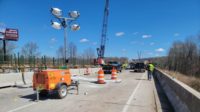
University researchers have unveiled a new concrete bridge bent system that they say reduces earthquake damage while speeding construction. The new rocking design uses octagonal, prefabricated, pretensioned concrete columns for added elasticity and a recentering effect that minimizes seismic-related structural damage and displacement. The structural support system’s critical components are created under factory conditions for improved quality and reduced erection time. The state transportation departments of California, Washington and Nevada have expressed early interest in adopting the bridge bent system, whose only size limitations stem from transportation logistics of precast columns and beams.
"The design of reinforced-concrete bridges in seismic regions has changed little since the mid-1970s," says John F. Stanton, a civil engineering professor at the University of Washington, Seattle, who developed the new underlying design concept, partly funded by a National Science Foundation award. “We're utilizing existing technologies in a new way that enables us to mitigate damage that would occur from a seismic event.”
The research team constructed a two-span bridge mock-up, at 25% scale, for shake-table testing on July 14-15 at the University of Nevada-Reno’s new $19 million, 24,500-sq-ft earthquake engineering laboratory, which opened last month. The results will soon be made available through the National Science Foundation’s George E. Brown Jr. Network for Earthquake Engineering Simulation. The system’s precast column design uses discontinuous reinforcing rebar and unbonded cable strands for tensioned support, which prevents stresses from collecting. Spread footing foundations are poured around roughened saw-tooth column ends to help transfer forces. Longitudinal reinforcing footing rebar is used without crossing the column connection. Bars use mechanical anchors within the embedded column footing—as opposed to having the bar ends bent out—with no protruding steel, making it easier and safer for transportation while improving performance. A steel jacket is added at each column end. Column tops connect to precast cap beams using large bars grouted into ducts.
The result localizes earthquake damage by allowing rocking at each column end. The design enables column cracking at the plane atop of the footing, so the column can then rock as a rigid body. Steel shoes, consisting of circular pipe welded to an end plate, form a discontinuity where the crack occurs, thereby confining and minimizing damage to the column ends while still holding elements in place.
“The focus has turned from preventing collapse to ensuring serviceability,” says UNR engineering professor David H. Sanders, who is a research team member along with UW engineering professor Marc O. Eberhard and graduate student assistants Travis Thonstad and Islam Mantawy. “Cyclic tests of the critical connections show the system can deform during strong earthquakes and return to plumb position with minimal damage.”
Mark Elicegui, Nevada Dept. of Transportation chief structures engineer, observed the shake-table testing on July 14. “Nevada is one of the most seismically active states in the U.S.," he says. "We’ve retrofitted approximately 120 bridges since we began including seismic design considerations as a part of our project prioritization. It’s particularly intriguing for us to have the chance to view potential new designs and technology for tensioning applications. It’s critical that research results then be adapted to ensure the applicability and safety of any new design onto our roads and bridges, and we look forward to how such technologies might be able to further enhance Nevada bridge design in the future.”
The concept will be presented at the 10th U.S. National Conference on Earthquake Engineering, or Quake Summit, on July 21-25 in Anchorage, Alaska.


Post a comment to this article
Report Abusive Comment